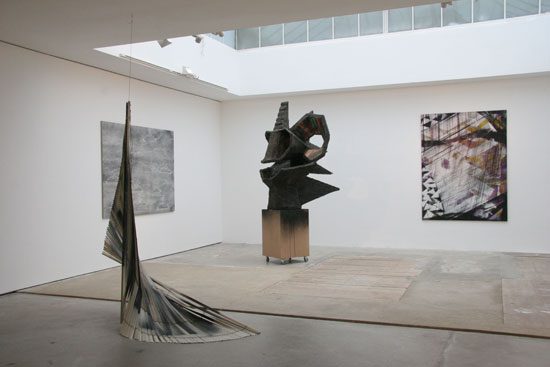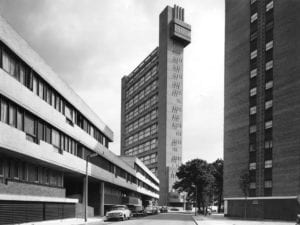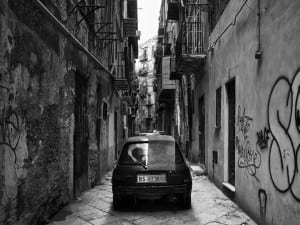The short walk from Oxford Circus to Paradise Row takes the visitor around the outskirts of Soho. Amidst the unrelenting flow of retail worshippers and diurnal revellers, a little knowledge of the area enables a sensual infusion of the manifold variety of human activity heightened by the sense that one is travsersing a hive of creavtivity. It is almost overwhelming. The collaborative projects of popular media seem to give way in their representation, at least at street level, to what,at first glance, seem to be the more modest concerns of personal expression on Newman Street. However, on entering Paradise Row the visitor finds that the thorough-going perusal warranted by the work displayed concentrates the temporarily relaxed engagement of the senses, and one leaves exhausted. Why? The works collected here have in common the aesthetic expression of the ineffable. This is explored through the tension between surface and depth. Six artists are represented here from the Netherlands, Poland, the USA, and the UK.
The first work encountered on entering, 6 (2010), by Gino Saccone, employs graphite and oil on a large (220 x 180 cm) canvas. It seems to reference the character Pac Man of pioneering games console fame, who seems to utter or emit something. The materials used lend gravitas to what seems to be a frivolous cultural reference. Taken out of context from other works by the artist it is an exhibit of confusing resonance. Given that the artist intends to open up psychological spaces, fictions and cultural references by inter-relating different elements of his work, perhaps other of his works ought to be exhibited here. That the resonance is confusing, however, suggests that the work is successful. Spoken Movie 5 (2010) by Wojciech Bakowski is an animated film and audio installation. The visitor enters a low door and is sealed into a large box containing stool and screen. The major sensory deprivation couples a certain uterine comfort with claustrophobic distress compounded by the organ music of the audio. It is both disconcerting and anodyne, rather like being a car passenger on the motorway.
Four works by Davina Semo follow, the strongest of which is He Had Just Begun To Realize… (2011). This involves an etched, transparent, circular mirror with enamel paint regularly spread in a sort of voluptuous cross-hatch pattern. Here, in combination with the title of the piece the resonances of self-image and emerging self-realisation, perhaps represented in the emerging pattern, can be felt. The ineffable is expressed with an element of viewer-participation. This piece leads the viewer to engage with the other pieces by Semo, tantalised by an evocation of the unutterable.
Four works by Coen Vunderink takes the viewer further round the space. The most imposing is Hizkia (2011). This large-scale sculpture seems to depict a sort of ancient god and is somewhat reminiscent of the Aztec Rain-god, Tlaloc (highlighted, as many readers will recall, by Professor Gombrich). It is fearsome and evokes a sense of ancient ritual, perhaps sacrifice, but is subverted by the assymetry of the piece. As such it is transported into the 21st century. With this in mind, Vunderink’s practice of demonstrating an ambiguous relationship between abstraction and figuration is achieved. Remarkable is Vunderink’s Untitled (2011), involving airbrush egg tempura on linen. Here, a chaos of linear regularities, executed with refined grace, evoke an ambiguity involving the whole of that which the work is part. It seems to be part of a mural, yet it has a balanced harmony and unity all its own. The limited use of colour is highly effective and expresses an ineffable multiplicity of connotations.
Justin Matherly’s Good. He’s a winner even when buried alive (2011), is one of two offerings that, in employing inkjet monoprint, fascinate the viewer with a very regular, somewhat soothing, pointillistic effect. Apparently depicted in the printed photograph is an archeological dig. Ancient civilisations and what survives of them today, and their relevance, can be felt to be connoted; yet there is something unreal about the depiction owing to the effect of the media. In an exhibition that plays on the tension between surface and depth, showing the beauty and difficulty of using aesthetic forms to express the inexpressible, it has a firm place. For a visual arts exhibition, the result of an engagement with many of the works was the evocation of feeling usually only accessed by music. However, the engagement itself requires much more effort. As such the exhibition succeeds on its own terms.
Everything’s Alright Forever, 7th July until 18th August 2012, Paradise Row, 74a Newman Street, London, W1T 3DB. www.paradiserow.com
Credit:
Courtesy of Paradise Row, Copyright the Artist.
Text: Daniel Potts





